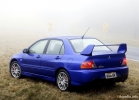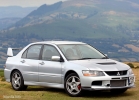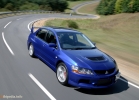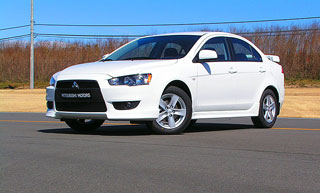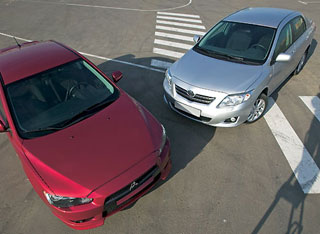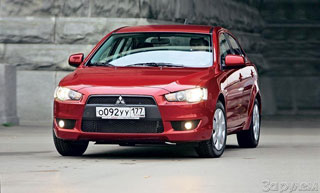Test drive Mitsubishi Lancer Evolution IX 2005 - 2007 sedan
Wolf skin
 The Japanese auto industry is characterized by a high frequency of updating the model rows. Mitsubishi is no exception. In the 24th year of Lancer output, the tenth generation of the car appeared in the dealers car dealerships.
The Japanese auto industry is characterized by a high frequency of updating the model rows. Mitsubishi is no exception. In the 24th year of Lancer output, the tenth generation of the car appeared in the dealers car dealerships. Never before I felt such an interest from others, being driving a car worth 20 with a small thousand dollars! At first I even thought that something was wrong with Lancer. Maybe the wheel was lowered? We went to the test the most expensive version of the car with a stylish body kit, provided only for the execution of Intense, and with a two -liter engine with a variator. I don’t know how it will be with cheaper assemblies, devoid of skirt along the thresholds, the posterior anti -winged -shaped anti -winged shape, and on the discs is simpler, but with all these bells and whistles, and even in red, the tenth Lancer is irresistible.
The design of an elongated body has a strong sports accent, alien to most classmates. Perhaps only Civic in this regard appears on equal terms with the new Lancer. Shark muzzle with a huge trapezoid of a radiator lattice and a powerful, but not heavy back (lanterns remind of Alfa 156 and 159), very bold solutions. The window sill line, emphasized by stamping along the body, goes to take off, giving the appearance additional dynamics. A spectacular car, with the tenth Lancer, the Japanese company got into the top ten puppet. And it seems that this is how the new style of the Mitsubishi passenger range will be. The ninth model was a gray mouse, unremarkable. But the new lancer is a dandy with a courageous aggressive face and a sports physique. Only 16-inch wheels with high-profile rubber (205/60) are spoiled, which are somewhat not knitted with a sports appearance, as well as an enlarged (for Russia) clearance.
 It turned out 165 mm, so behind the car looks excessively high. Inside the new Lancer is much calmer. One gets the impression that the interior was developed separately from the exterior. Some hints of sports, such as inserts for Kevlar, do not save the situation. The front panel and steering wheel are borrowed from Mitsubishi Outlander XL. But if there are no complaints about the leather steering wheel with the Audiosystem control buttons (the section and the form are suitable), then the quality of the panel and the upper part of the doors raised questions. Shiny hard plastic responds to tapping with a echoing sound.
It turned out 165 mm, so behind the car looks excessively high. Inside the new Lancer is much calmer. One gets the impression that the interior was developed separately from the exterior. Some hints of sports, such as inserts for Kevlar, do not save the situation. The front panel and steering wheel are borrowed from Mitsubishi Outlander XL. But if there are no complaints about the leather steering wheel with the Audiosystem control buttons (the section and the form are suitable), then the quality of the panel and the upper part of the doors raised questions. Shiny hard plastic responds to tapping with a echoing sound. In terms of ergonomics, no revelations. It is quite convenient to sit down, but I would like to lower the chair below, and adjust the steering column by departure. However, this adjustment did not appear and on the tenth generation of the Mitsubishi model stubbornly ignores the interests of tall drivers. Planting the car is similar to Outlander. The chair was not remembered by the usual, not tough, and not soft, with conditional lateral support. The back is spacious, this is the merit of the grown base (plus 35 mm) and the total body dimensions. A review through the rear -view mirror became a victim of the original appearance of the panorama cut in half with a beautiful rear spoiler.
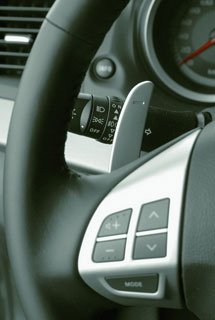 The steering wheel switches are ergonomic, and three twins microclimate, in my opinion, is unsurpassed by ease of use. The Sport Mode CVT variator operating mode, although it is not sheathed not very high -quality skin, but quite conveniently lies in the palm of your hand.
The steering wheel switches are ergonomic, and three twins microclimate, in my opinion, is unsurpassed by ease of use. The Sport Mode CVT variator operating mode, although it is not sheathed not very high -quality skin, but quite conveniently lies in the palm of your hand. Maybe on the go Lancer will play along with its sports appearance? I did not play played out, do not think that this is a slow car, for its class it is quite dynamic. The MIVEC engine has a power of 150 forces, which, you see, is a lot. But there is not so much for the equipped mass of 1400 kg. Nevertheless, the sedan cheerfully accelerates, the adaptive variator without delay and breaks conveys the moment to the wheels. The pedal is on the floor and few of the neighbors will leave the traffic light as aground. But there is no sports enthusiasm for overclocking. However, a car with a variator can rarely cause driver delight. And no one will like the dry roar of the motor, hung at the moment with intense acceleration.
Managing acceleration is inconvenient. The variator often unjustifies the engine to high speeds. Sometimes it is better to release the pedal a little to switch to the next gear. The steering wheel switches correct the situation a little, but you won’t click them all the time, and then why is a smart Sport Mode? Eh, here would be a pen! In the end, the variator presented an unpleasant surprise at a speed of about 180 km/h. To attempts to add a little gas, he instantly reacted with switching to the step down. The engine roared, I released the pedal a little, and then there was a reverse switch. Very nervous behavior is about a slight press on the pedal.
I note that Lancer gives enough comfort at speeds at 200 km/h. The driver does not have to strain, sound insulation is not bad. Only twisting in the area of \u200b\u200bthe front mirrors after 140150 km/h create a distinct noise. There are no sport in handling, but there is confidence, reliability. And straightforwardness. In other words, here Lancer is as dry as the sound of its motor. The car goes like an average classmate, without a light. It includes tangible rolls (though, here you can blame high -profile tires and enlarged clearance). The gas responds to the discharge of gas with the expected smooth drift. The connection on the steering wheel is present, but it seems unnatural. The strength of the new Lancer movement in a straight line with high speed. The energy -intensive suspension is going, the steering wheel is clearly at zero.
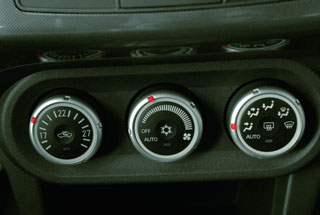 The new Mitsubishi Lancer left conflicting impressions. On one side of the scales, perhaps the most interesting appearance in the class, a powerful engine, on the other a straightforward interior, a strange algorithm for the work of the variator, fresh controllability. And will Lancer be also attractive without body kit? Will it also be dynamic with a 1.5 liter engine? In addition, the prices for the model are now starting at $ 18,000. There is something to think about
The new Mitsubishi Lancer left conflicting impressions. On one side of the scales, perhaps the most interesting appearance in the class, a powerful engine, on the other a straightforward interior, a strange algorithm for the work of the variator, fresh controllability. And will Lancer be also attractive without body kit? Will it also be dynamic with a 1.5 liter engine? In addition, the prices for the model are now starting at $ 18,000. There is something to think about Prices and configuration
The dealers offer Mitsubishi Lancer with two MIVEC gasoline engines with a volume of 1.5 liters (109 hp) and 2.0 liters (150 hp). Both are aggregated with a 5-speed manual transmission. For a 1.5 l motor, an automatic machine with five steps is possible, and for a 2-liter variator with the possibility of manual switching. There are three Invite, Invite with plus and Intense. The price of the simplest Invite 1.5 with a mechanics $ 17,990. The Invite execution with a plus adds a CD-racer with an MP3, a steering wheel, covered with skin, with an audio control buttons, front fog, alloy wheels. In the Intense, the air conditioner is replaced by climate control, an additionally installed 6-disk chainer, an aerodynamic body kit in the color of the body, the rear anti-wing, the side pillows and the driver's knees. The machine that has been on our test (Intense equipment, 2-liter engine, CVT variable) costs $ 24,300.
History of Mitsubishi Lancer
 The Lancer model (from English Ulan) was born in 1973. With her, Mitsubishi decided to fill in the gap between Minica and Galant in the Japanese market. Intra -final designation LA. According to the modern classification, that Lancer would be in the Lower-Medium segment. In Australia, it was called Chrysler Valiant Lancer, in America Dodge Colt. The model was produced in the body of the compartment, sedan and station wagon; The latter already had the designation of Station Wagon, which has been preserved so far. In total, there were 12 configurations, starting with the base 1.2 l and ending with the most powerful 1.6 L GSR. In 1975, the lineup was replenished with a three -door hatchback, which was called Mitsubishi Lancer Celeste (in some Mitsubishi Celeste or Colt Celeste markets, in Australia Chrysler Lancer Coupe, in the USA Plymouth Arrow). It was produced with 1.4 and 1.6-liter engines, then 2-liter was added to them. A little later, the Lancer restyling was carried out, in connection with which the factory index changed to LB.
The Lancer model (from English Ulan) was born in 1973. With her, Mitsubishi decided to fill in the gap between Minica and Galant in the Japanese market. Intra -final designation LA. According to the modern classification, that Lancer would be in the Lower-Medium segment. In Australia, it was called Chrysler Valiant Lancer, in America Dodge Colt. The model was produced in the body of the compartment, sedan and station wagon; The latter already had the designation of Station Wagon, which has been preserved so far. In total, there were 12 configurations, starting with the base 1.2 l and ending with the most powerful 1.6 L GSR. In 1975, the lineup was replenished with a three -door hatchback, which was called Mitsubishi Lancer Celeste (in some Mitsubishi Celeste or Colt Celeste markets, in Australia Chrysler Lancer Coupe, in the USA Plymouth Arrow). It was produced with 1.4 and 1.6-liter engines, then 2-liter was added to them. A little later, the Lancer restyling was carried out, in connection with which the factory index changed to LB.  The second generation of the model appeared in 1979 and in Japan was called Lancer EX. The second Ulan was much more angular than the predecessor. It was produced only in the form of a 4-door sedan. In 1980, a modification with a 1.8 l turbo engine was released.
The second generation of the model appeared in 1979 and in Japan was called Lancer EX. The second Ulan was much more angular than the predecessor. It was produced only in the form of a 4-door sedan. In 1980, a modification with a 1.8 l turbo engine was released.  In 1982, the Light saw the third Lancer (Lancer Fiore in the Japanese market). The base for him was Mitsubishi Mirage (model for the domestic market). Lancer was exported in versions of a 5-door hatchback (just Lancer) and Miraage Sedan. In Australia, Lancer was sold under the name Mitsubishi Colt Sedan. Thus, Mitsubishi at that time had two identical models in the same Mirage and Lancer class.
In 1982, the Light saw the third Lancer (Lancer Fiore in the Japanese market). The base for him was Mitsubishi Mirage (model for the domestic market). Lancer was exported in versions of a 5-door hatchback (just Lancer) and Miraage Sedan. In Australia, Lancer was sold under the name Mitsubishi Colt Sedan. Thus, Mitsubishi at that time had two identical models in the same Mirage and Lancer class.  The next 1983, both Lancer and Mirage were renewed, which is considered to be the release of the fourth generation of the model. Mirage sedan did not offer only Lancer. Engines with fuel injection and turboponers appeared. In 1985, the fourth -generation Lancer line was complemented by the Station Wagon station wagon, which was equipped with all -wheel drive. Since then, only a 3-door hatchback has been called Mirage (or Colt), and other body versions of Lancer. This generation of the model has become the basis for the first Malaysian car Proton Saga.
The next 1983, both Lancer and Mirage were renewed, which is considered to be the release of the fourth generation of the model. Mirage sedan did not offer only Lancer. Engines with fuel injection and turboponers appeared. In 1985, the fourth -generation Lancer line was complemented by the Station Wagon station wagon, which was equipped with all -wheel drive. Since then, only a 3-door hatchback has been called Mirage (or Colt), and other body versions of Lancer. This generation of the model has become the basis for the first Malaysian car Proton Saga. 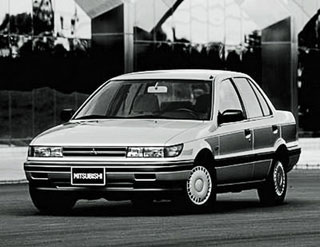 The fifth -generation Mitsubishi Lancer, which entered the market in 1987,, following the example of his older brother, had an aerodynamic body. The names of Mirage and Lancer are preserved. In Australia, all body versions were sold as Mitsubishi Lancer, the sedan in Japan was named Miraage Aspire, and in the USA Dodge Lancer.
The fifth -generation Mitsubishi Lancer, which entered the market in 1987,, following the example of his older brother, had an aerodynamic body. The names of Mirage and Lancer are preserved. In Australia, all body versions were sold as Mitsubishi Lancer, the sedan in Japan was named Miraage Aspire, and in the USA Dodge Lancer.  The sixth Lancer, which was published in 1992, already had a platform different from Mirage. In America, the Mirage sedan was sold as Eagle Summit. A year later, a version of the station wagon appeared (Libero in the Japanese market). At the same time, Lancer received a V6 engine with a volume of only 1.6 liters (the smallest V6 at that time). In September 1993, the GSR modification with a 4G93 turbo engine with a volume of 1.8 liters and with all-wheel drive transmission from the Galant VR-4 Foreign Evolution Tourboat entered the market. The two -door coupe in Japan was called Mirage Asti Coupe, and in the foreign markets Lancer Coupe.
The sixth Lancer, which was published in 1992, already had a platform different from Mirage. In America, the Mirage sedan was sold as Eagle Summit. A year later, a version of the station wagon appeared (Libero in the Japanese market). At the same time, Lancer received a V6 engine with a volume of only 1.6 liters (the smallest V6 at that time). In September 1993, the GSR modification with a 4G93 turbo engine with a volume of 1.8 liters and with all-wheel drive transmission from the Galant VR-4 Foreign Evolution Tourboat entered the market. The two -door coupe in Japan was called Mirage Asti Coupe, and in the foreign markets Lancer Coupe. 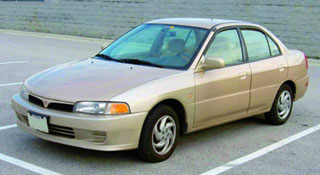 The seventh generation, which appeared in 1995, was built on the last platform, and was essentially a serious update of the sixth. In the line of engines, it was decided to leave only 1.5 and 1.8-liter engines. In the period from 1996 to 2004 in some Lancer markets, it was replaced by the Mitsubishi Carisma model.
The seventh generation, which appeared in 1995, was built on the last platform, and was essentially a serious update of the sixth. In the line of engines, it was decided to leave only 1.5 and 1.8-liter engines. In the period from 1996 to 2004 in some Lancer markets, it was replaced by the Mitsubishi Carisma model. 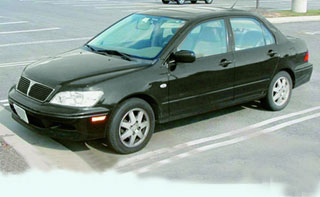 In 2000, Japan began to sell the actually the eighth Lancer model of CEDIA (from Century Diamond), although the seventh generation and Carisma were still offered in most external markets. CEDIA was available with two types of body: sedan and station wagon Station Wagon. Well, Mirage has become a separate model. In 2002, CEDIA appeared in the USA and Australia.
In 2000, Japan began to sell the actually the eighth Lancer model of CEDIA (from Century Diamond), although the seventh generation and Carisma were still offered in most external markets. CEDIA was available with two types of body: sedan and station wagon Station Wagon. Well, Mirage has become a separate model. In 2002, CEDIA appeared in the USA and Australia.  The ninth generation of Lancer is considered to be the result of restyling CEDIA, conducted in 2003. In the same year, Lancer returned to Europe. This model, which we most often meet today on the streets, came Lancer, the test report is published in this motor issue.
The ninth generation of Lancer is considered to be the result of restyling CEDIA, conducted in 2003. In the same year, Lancer returned to Europe. This model, which we most often meet today on the streets, came Lancer, the test report is published in this motor issue. Dmitry Krotov


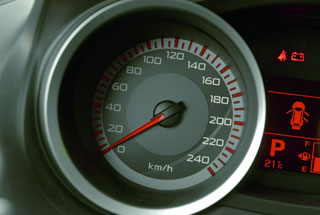

Source: Motor magazine [July 2007]



